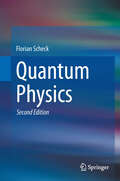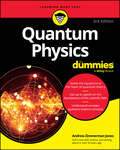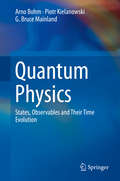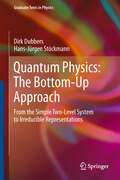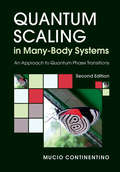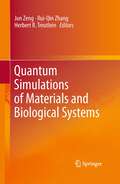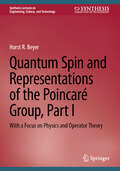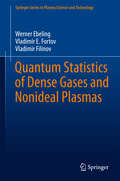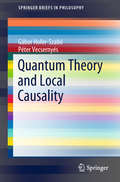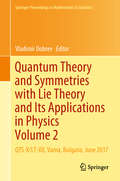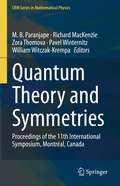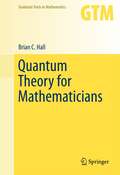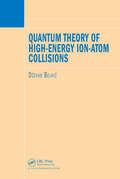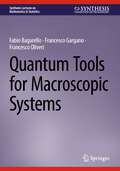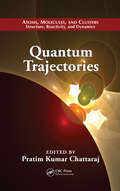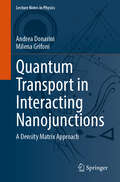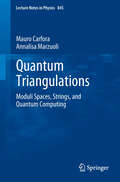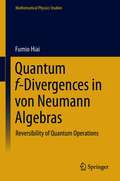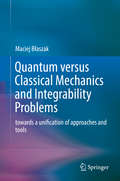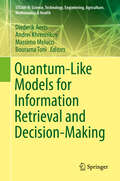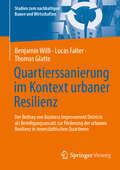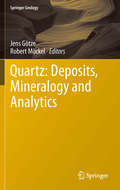- Table View
- List View
Quantum Phase Transitions
by Subir SachdevDescribing the physical properties of quantum materials near critical points with long-range many-body quantum entanglement, this book introduces readers to the basic theory of quantum phases, their phase transitions and their observable properties. This second edition begins with a new section suitable for an introductory course on quantum phase transitions, assuming no prior knowledge of quantum field theory. It also contains several new chapters to cover important recent advances, such as the Fermi gas near unitarity, Dirac fermions, Fermi liquids and their phase transitions, quantum magnetism, and solvable models obtained from string theory. After introducing the basic theory, it moves on to a detailed description of the canonical quantum-critical phase diagram at non-zero temperatures. Finally, a variety of more complex models are explored. This book is ideal for graduate students and researchers in condensed matter physics and particle and string theory.
Quantum Physics
by Florian ScheckScheck's Quantum Physics presents a comprehensive introductory treatment, ideally suited for a two-semester course. Part One covers the basic principles and prime applications of quantum mechanics, from the uncertainty relations to many-body systems. Part Two introduces to relativistic quantum field theory and ranges from symmetries in quantum physics to electroweak interactions. Numerous worked-out examples as well as exercises, with solutions or hints, enables the book's use as an accompanying text for courses, and also for independent study. For both parts, the necessary mathematical framework is treated in adequate form and detail. The book ends with appendices covering mathematical fundamentals and enrichment topics, plus selected biographical notes on pioneers of quantum mechanics and quantum field theory. The new edition was thoroughly revised and now includes new sections on quantization using the path integral method and on deriving generalized path integrals for bosonic and fermionic fields.
Quantum Physics For Dummies
by Andrew Zimmerman JonesThe plain-English guide to understanding quantum physics Mastering quantum physics is no easy feat, but with the help of Quantum Physics For Dummies you can work at your own pace to unlock key concepts and fascinating facts. Packed with invaluable explanations, equations, and step-by-step instructions, this book makes a challenging subject much more accessible. Great for college students taking a quantum physics course, Quantum Physics For Dummies offers complete coverage of the subject, along with numerous examples to help you tackle the tough stuff. The Schrodinger Equation, the foundations of quantum physics, vector notation, scattering theory, angular momentum—it’s all in here. This handy guide helps you prepare for exams and succeed at learning quantum physics. Get clear explanations of the core concepts in quantum physics Review the math principles needed for quantum physics equations Learn the latest breakthroughs and research in the field Clarify difficult subjects and equations from your college courseQuantum Physics For Dummies is great a resource for students who need a supplement to the textbook to help them tackle this challenging subject.
Quantum Physics: States, Observables and Their Time Evolution (Texts And Monographs In Physics #348)
by Piotr Kielanowski Arno Bohm G. Bruce MainlandThis is an introductory graduate course on quantum mechanics, which is presented in its general form by stressing the operator approach. Representations of the algebra of the harmonic oscillator and of the algebra of angular momentum are determined in chapters 1 and 2 respectively. The algebra of angular momentum is enlarged by adding the position operator so that the algebra can be used to describe rigid and non-rigid rotating molecules. The combination of quantum physical systems using direct-product spaces is discussed in chapter 3. The theory is used to describe a vibrating rotator, and the theoretical predictions are then compared with data for a vibrating and rotating diatomic molecule. The formalism of first- and second-order non-degenerate perturbation theory and first-order degenerate perturbation theory are derived in chapter 4. Time development is described in chapter 5 using either the Schroedinger equation of motion or the Heisenberg’s one. An elementary mathematical tutorial forms a useful appendix for the readers who don’t have prior knowledge of the general mathematical structure of quantum mechanics.
Quantum Physics: The Bottom-Up Approach
by Dirk Dubbers Hans-Jürgen StöckmannThis concise tutorial provides the bachelor student and the practitioner with a short text on quantum physics that allows them to understand a wealth of quantum phenomena based on a compact, well readable, yet still concise and accurate description of nonrelativistic quantum theory. This "quadrature of the circle" is achieved by concentrating first on the simplest quantum system that still displays all basic features of quantum theory, namely, a system with only two quantized energy levels. For most readers it is very helpful to understand such simple systems before slowly proceeding to more demanding topics like particle entanglement, quantum chaos, or the use of irreducible tensors. This tutorial does not intend to replace the standard textbooks on quantum mechanics, but will help the average student to understand them, often for the first time.
Quantum Scaling In Many-body Systems
by Mucio ContinentinoThis book on quantum phase transitions has been written by one of the pioneers in the application of scaling ideas to many-body systems OCo a new and exciting subject that has relevance to many areas of condensed matter and theoretical physics. One of the few books on the subject, it emphasizes strongly correlated electronic systems. Although dealing with complex problems in statistical mechanics, it does not lose sight of the experiments and the actual physical systems which motivate the theoretical work. The book starts by presenting the scaling theory of quantum critical phenomena. Critical exponents for different systems are calculated using both the momentum space and real space renormalization group approaches. The former is developed without the use of Feynman diagrams, allowing nonspecialists to fully appreciate the underlying physics of this method. The case of heavy fermions as an example of systems close to a zero temperature phase transition is presented and discussed in detail. This is also the case of non-Fermi liquid behavior associated with a quantum critical point. MetalOCoinsulator transitions are discussed within the scaling approach. The book ends with a discussion on first order quantum phase transitions, in particular those which occur due to a fluctuation-induced mechanism. Contents: Scaling Theory of Quantum Critical Phenomena; Landau and Gaussian Theories; Renormalization Group: The A-Expansion; Quantum Phase Transitions; Real Space Renormalization Group Approach; Heavy Fermions; A Microscopic Model for Heavy Fermions; MetalOCoInsulator Transitions; Density-Driven MetalOCoInsulator Transitions; Mott Transitions; The Nonlinear Sigma Model; Fluctuation-Induced Quantum Phase Transitions. Readership: Graduate students, lecturers and researchers in condensed matter physics. "
Quantum Simulations of Materials and Biological Systems
by Rui-Qin Zhang Jun Zeng Herbert TreutleinQuantum Simulations of Materials and Biological Systems features contributions from leading world experts in the fields of density functional theory (DFT) and its applications to material and biological systems. The recent developments of correlation functionals, implementations of Time-dependent algorithm into DFTB+ method are presented. The applications of DFT method to large materials and biological systems such as understanding of optical and electronic properties of nanoparticles, X-ray structure refinement of proteins, the catalytic process of enzymes and photochemistry of phytochromes are detailed. In addition, the book reviews the recent developments of methods for protein design and engineering, as well as ligand-based drug design. Some insightful information about the 2011 International Symposium on Computational Sciences is also provided. Quantum Simulations of Materials and Biological Systems is aimed at faculties and researchers in the fields of computational physics, chemistry and biology, as well as at the biotech and pharmaceutical industries.
Quantum Spin and Representations of the Poincaré Group, Part I: With a Focus on Physics and Operator Theory (Synthesis Lectures on Engineering, Science, and Technology)
by Horst R. BeyerThis book discusses how relativistic quantum field theories must transform under strongly continuous unitary representations of the Poincaré group. The focus is on the construction of the representations that provide the basis for the formulation of current relativistic quantum field theories of scalar fields, the Dirac field, and the electromagnetic field. Such construction is tied to the use of the methods of operator theory that also provide the basis for the formulation of quantum mechanics, up to the interpretation of the measurement process. In addition, since representation spaces of primary interest in quantum theory are infinite dimensional, the use of these methods is essential. Consequently, the book also calculates the generators of relevant strongly continuous one-parameter groups that are associated with the representations and, where appropriate, the corresponding spectrum. Part I of Quantum Spin and Representations of the Poincaré Group specifically addresses: conventions; basic properties of SO(2) and SO(3); construction of a double cover of SO(3); SU(2) spinors; continuous unitary representation of SU(2); basic properties of the Lorentz Group; unitary representation of the restricted Lorentz Group; an extension to a strongly continuous representation of the restricted Poincaré Group; and an extension to a unitary/anti-unitary representation of the Poincaré Group.
Quantum Statistics of Dense Gases and Nonideal Plasmas
by Werner Ebeling Vladimir E. Fortov Vladimir FilinovThe aim of this book is the pedagogical exploration of the basic principles of quantum-statistical thermodynamics as applied to various states of matter - ranging from rare gases to astrophysical matter with high-energy density. The reader will learn in this work that thermodynamics and quantum statistics are still the concepts on which even the most advanced research is operating - despite of a flood of modern concepts, classical entities like temperature, pressure, energy and entropy are shown to remain fundamental. The physics of gases, plasmas and high-energy density matter is still a growing field and even though solids and liquids dominate our daily life, more than 99 percent of the visible Universe is in the state of gases and plasmas and the overwhelming part of matter exists at extreme conditions connected with very large energy densities, such as in the interior of stars. This text, combining material from lectures and advanced seminars given by the authors over many decades, is a must-have introduction and reference for both newcomers and seasoned researchers alike.
Quantum Theory and Local Causality (SpringerBriefs in Philosophy)
by Gábor Hofer-Szabó Péter VecsernyésThis book summarizes the results of research the authors have pursued in the past years on the problem of implementing Bell's notion of local causality in local physical theories and relating it to other important concepts and principles in the foundations of physics such as the Common Cause Principle, Bell's inequalities, the EPR (Einstein-Podolsky-Rosen) scenario, and various other locality and causality concepts. The book is intended for philosophers of science with an interest in the formal background of sciences, philosophers of physics and physicists working in foundation of physics.
Quantum Theory and Symmetries with Lie Theory and Its Applications in Physics Volume 2: QTS-X/LT-XII, Varna, Bulgaria, June 2017 (Springer Proceedings in Mathematics & Statistics #255)
by Vladimir DobrevThis book is the second volume of the proceedings of the joint conference X. International Symposium “Quantum Theory and Symmetries” (QTS-X) and XII. International Workshop “Lie Theory and Its Applications in Physics” (LT-XII), 19–25 June 2017, Varna, Bulgaria.The QTS series started around the core concept that symmetries underlie all descriptions of quantum systems. It has since evolved into a symposium on the frontiers of theoretical and mathematical physics. The LT series covers the whole field of Lie Theory in its widest sense together with its applications in many facets of physics. As an interface between mathematics and physics the workshop serves as a meeting place for mathematicians and theoretical and mathematical physicists.In the division of the material between the two volumes, the Editor has tried to select for the first and second volumes papers that are more oriented toward mathematics and physics, respectively. However, this division is relative since many papers could have been placed in either volume. The topics covered in this volume represent the most modern trends in the fields of the joint conferences: symmetries in string theories, conformal field theory, holography, gravity theories and cosmology, gauge theories, foundations of quantum theory, nonrelativistic and classical theories.
Quantum Theory and Symmetries: Proceedings of the 11th International Symposium, Montreal, Canada (CRM Series in Mathematical Physics)
by Pavel Winternitz M. B. Paranjape Richard MacKenzie Zora Thomova William Witczak-KrempaThis volume of the CRM Conference Series is based on a carefully refereed selection of contributions presented at the "11th International Symposium on Quantum Theory and Symmetries", held in Montréal, Canada from July 1-5, 2019. The main objective of the meeting was to share and make accessible new research and recent results in several branches of Theoretical and Mathematical Physics, including Algebraic Methods, Condensed Matter Physics, Cosmology and Gravitation, Integrability, Non-perturbative Quantum Field Theory, Particle Physics, Quantum Computing and Quantum Information Theory, and String/ADS-CFT. There was also a special session in honour of Decio Levi. The volume is divided into sections corresponding to the sessions held during the symposium, allowing the reader to appreciate both the homogeneity and the diversity of mathematical tools that have been applied in these subject areas. Several of the plenary speakers, who are internationally recognized experts in their fields, have contributed reviews of the main topics to complement the original contributions.
Quantum Theory for Mathematicians
by Brian C. HallAlthough ideas from quantum physics play an important role in many parts of modern mathematics, there are few books about quantum mechanics aimed at mathematicians. This book introduces the main ideas of quantum mechanics in language familiar to mathematicians. Readers with little prior exposure to physics will enjoy the book's conversational tone as they delve into such topics as the Hilbert space approach to quantum theory; the Schrödinger equation in one space dimension; the Spectral Theorem for bounded and unbounded self-adjoint operators; the Stone-von Neumann Theorem; the Wentzel-Kramers-Brillouin approximation; the role of Lie groups and Lie algebras in quantum mechanics; and the path-integral approach to quantum mechanics. The numerous exercises at the end of each chapter make the book suitable for both graduate courses and independent study. Most of the text is accessible to graduate students in mathematics who have had a first course in real analysis, covering the basics of L2 spaces and Hilbert spaces. The final chapters introduce readers who are familiar with the theory of manifolds to more advanced topics, including geometric quantization.
Quantum Theory of High-Energy Ion-Atom Collisions
by Dzevad BelkicOne of the Top Selling Physics Books according to YBP Library ServicesSuitable for graduate students, experienced researchers, and experts, this book provides a state-of-the-art review of the non-relativistic theory of high-energy ion-atom collisions. Special attention is paid to four-body interactive dynamics through the most important theoretical
Quantum Tools for Macroscopic Systems (Synthesis Lectures on Mathematics & Statistics)
by Fabio Bagarello Francesco Oliveri Francesco GarganoThis book describes how complex systems from a variety of fields can be modeled using quantum mechanical ideas; from biology and ecology, to sociology and decision-making. Quantum mechanics is traditionally associated with microscopic systems; however, quantum concepts have also been successfully applied to a wide range of macroscopic systems both within and outside physics. The mathematical basis of these models is covered in detail, providing a self-contained and consistent approach. This book provides unique insight into the dynamics of these macroscopic systems and opens new interdisciplinary research frontiers. The authors present an essential resource for researchers in applied mathematics or theoretical physics who are interested in applying quantum mechanics to complex systems in the social, biological or ecological sciences.Describes how complex systems from a variety of fields can be modeled using quantum mechanical ideasProvides insight into the dynamics of macroscopic systems and opens new interdisciplinary research frontiersIntroduces quantum tools needed for the analysis of the dynamical behavior of macroscopic systems
Quantum Trajectories (Atoms, Molecules, and Clusters)
by Pratim Kumar ChattarajThe application of quantum mechanics to many-particle systems has been an active area of research in recent years as researchers have looked for ways to tackle difficult problems in this area. The quantum trajectory method provides an efficient computational technique for solving both stationary and time-evolving states, encompassing a large area o
Quantum Transport
by Yuli V. Nazarov Yaroslav M. BlanterQuantum transport is a diverse field, sometimes combining seemingly contradicting concepts - quantum and classical, conduction and insulating - within a single nanodevice. Quantum transport is an essential and challenging part of nanoscience, and understanding its concepts and methods is vital to the successful fabrication of devices at the nanoscale. This textbook, first published in 2009, is a comprehensive introduction to the rapidly developing field of quantum transport. The authors present the comprehensive theoretical background, and explore the groundbreaking experiments that laid the foundations of the field. Ideal for graduate students, each section contains control questions and exercises to check readers' understanding of the topics covered. Its broad scope and in-depth analysis of selected topics will appeal to researchers and professionals working in nanoscience.
Quantum Transport in Interacting Nanojunctions: A Density Matrix Approach (Lecture Notes in Physics #1024)
by Andrea Donarini Milena GrifoniThis book serves as an introduction to the growing field of quantum many-body transport in interacting nanojunctions. It delves into a theoretical approach based on a general density-matrix formulation for open quantum systems. In the book, relevant transport observables, like the current or its higher order cumulants, are obtained by evaluating quantum statistical averages. This approach requires the knowledge of the reduced density matrix of the interacting nanosystems. The formulation for addressing transport problems, based on the evolution of the reduced density operator in Liouville space, is highly versatile. It enables the treatment of charge and spin transport across various realistic nanostructures. Topics encompass standard Coulomb blockade, cotunneling phenomena in quantum dots, vibrational and Franck-Condon effects in molecular junctions, as well as many-body interference observed in double quantum dots or carbon nanotubes. Derived from lectures tailored for graduate and advanced students at the University of Regensburg in Germany, this book is enriched with exercises and step-by-step derivations.
Quantum Triangulations
by Annalisa Marzuoli Mauro CarforaResearch on polyhedral manifolds often points to unexpected connections between very distinct aspects of Mathematics and Physics. In particular triangulated manifolds play quite a distinguished role in such settings as Riemann moduli space theory, strings and quantum gravity, topological quantum field theory, condensed matter physics, and critical phenomena. Not only do they provide a natural discrete analogue to the smooth manifolds on which physical theories are typically formulated, but their appearance is rather often a consequence of an underlying structure which naturally calls into play non-trivial aspects of representation theory, of complex analysis and topology in a way which makes manifest the basic geometric structures of the physical interactions involved. Yet, in most of the existing literature, triangulated manifolds are still merely viewed as a convenient discretization of a given physical theory to make it more amenable for numerical treatment. The motivation for these lectures notes is thus to provide an approachable introduction to this topic, emphasizing the conceptual aspects, and probing, through a set of cases studies, the connection between triangulated manifolds and quantum physics to the deepest. This volume addresses applied mathematicians and theoretical physicists working in the field of quantum geometry and its applications.
Quantum f-Divergences in von Neumann Algebras: Reversibility of Quantum Operations (Mathematical Physics Studies)
by Fumio HiaiRelative entropy has played a significant role in various fields of mathematics and physics as the quantum version of the Kullback–Leibler divergence in classical theory. Many variations of relative entropy have been introduced so far with applications to quantum information and related subjects. Typical examples are three different classes, called the standard, the maximal, and the measured f-divergences, all of which are defined in terms of (operator) convex functions f on (0,∞) and have respective mathematical and information theoretical backgrounds. The α-Rényi relative entropy and its new version called the sandwiched α-Rényi relative entropy have also been useful in recent developments of quantum information.In the first half of this monograph, the different types of quantum f-divergences and the Rényi-type divergences mentioned above in the general von Neumann algebra setting are presented for study. While quantum information has been developing mostly in the finite-dimensional setting, it is widely believed that von Neumann algebras provide the most suitable framework in studying quantum information and related subjects. Thus, the advance of quantum divergences in von Neumann algebras will be beneficial for further development of quantum information. Quantum divergences are functions of two states (or more generally, two positive linear functionals) on a quantum system and measure the difference between the two states. They are often utilized to address such problems as state discrimination, error correction, and reversibility of quantum operations. In the second half of the monograph, the reversibility/sufficiency theory for quantum operations (quantum channels) between von Neumann algebras via quantum f-divergences is explained, thus extending and strengthening Petz' previous work.For the convenience of the reader, an appendix including concise accounts of von Neumann algebras is provided.
Quantum versus Classical Mechanics and Integrability Problems: towards a unification of approaches and tools
by Maciej BłaszakThis accessible monograph introduces physicists to the general relation between classical and quantum mechanics based on the mathematical idea of deformation quantization and describes an original approach to the theory of quantum integrable systems developed by the author.The first goal of the book is to develop of a common, coordinate free formulation of classical and quantum Hamiltonian mechanics, framed in common mathematical language.In particular, a coordinate free model of quantum Hamiltonian systems in Riemannian spaces is formulated, based on the mathematical idea of deformation quantization, as a complete physical theory with an appropriate mathematical accuracy.The second goal is to develop of a theory which allows for a deeper understanding of classical and quantum integrability. For this reason the modern separability theory on both classical and quantum level is presented. In particular, the book presents a modern geometric separability theory, based on bi-Poissonian and bi-presymplectic representations of finite dimensional Liouville integrable systems and their admissible separable quantizations.The book contains also a generalized theory of classical Stäckel transforms and the discussion of the concept of quantum trajectories.In order to make the text consistent and self-contained, the book starts with a compact overview of mathematical tools necessary for understanding the remaining part of the book. However, because the book is dedicated mainly to physicists, despite its mathematical nature, it refrains from highlighting definitions, theorems or lemmas.Nevertheless, all statements presented are either proved or the reader is referred to the literature where the proof is available.
Quantum-Like Models for Information Retrieval and Decision-Making (STEAM-H: Science, Technology, Engineering, Agriculture, Mathematics & Health)
by Bourama Toni Andrei Khrennikov Diederik Aerts Massimo MelucciRecent years have been characterized by tremendous advances in quantum information and communication, both theoretically and experimentally. In addition, mathematical methods of quantum information and quantum probability have begun spreading to other areas of research, beyond physics. One exciting new possibility involves applying these methods to information science and computer science (without direct relation to the problems of creation of quantum computers). The aim of this Special Volume is to encourage scientists, especially the new generation (master and PhD students), working in computer science and related mathematical fields to explore novel possibilities based on the mathematical formalisms of quantum information and probability. The contributing authors, who hail from various countries, combine extensive quantum methods expertise with real-world experience in application of these methods to computer science. The problems considered chiefly concern quantum information-probability based modeling in the following areas: information foraging; interactive quantum information access; deep convolutional neural networks; decision making; quantum dynamics; open quantum systems; and theory of contextual probability. The book offers young scientists (students, PhD, postdocs) an essential introduction to applying the mathematical apparatus of quantum theory to computer science, information retrieval, and information processes.
Quartierssanierung im Kontext urbaner Resilienz: Der Beitrag von Business Improvement Districts als Beteiligungsansatz zur Förderung der urbanen Resilienz in innerstädtischen Quartieren (Studien zum nachhaltigen Bauen und Wirtschaften)
by Thomas Glatte Lucas Falter Benjamin WilliStädte und ihre Quartiere sind Transformationsprozessen unterworfen und stehen nach Krisen wie der Corona-Pandemie vor großen Herausforderungen. Diese Publikation aus der Reihe „Studien zum nachhaltigen Bauen und Wirtschaften” untersucht in welcher Konstellation und unter welchen Bedingungen Business Improvement Districts (BIDs) als ein Beteiligungsinstrument der Quartiersentwicklung für die Stärkung der urbanen Resilienz eingesetzt werden können. Dabei wird auch der Frage nachgegegangen wer für die Umsetzung resilienter Stadtentwicklung verantwortlich ist und was konkret in einem Quartier resilient gestaltet werden soll.
Quartz: Deposits, Mineralogy and Analytics
by Jens Götze Robert MöckelThe book will include contributions of the state of the art of quartz raw materials (deposits and properties) and their analytics. The chapters are presented by leading scientists in the quartz field. The presentations cover the main interrelations between genesis of quartz - formation of specific properties - analytics - industrial applications of SiO2 raw materials.
Quartz: Deposits, Mineralogy and Analytics (Springer Geology)
by Jens Götze Robert MöckelThe book will include contributions of the state of the art of quartz raw materials (deposits and properties) and their analytics. The chapters are presented by leading scientists in the quartz field. The presentations cover the main interrelations between genesis of quartz - formation of specific properties - analytics - industrial applications of SiO2 raw materials.

